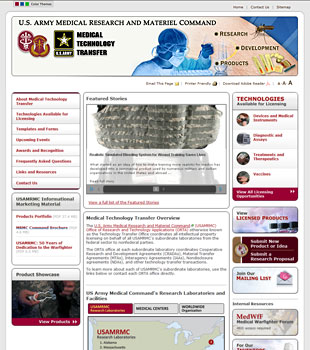USAMRMC Office of Research and Technology Applications Receives Designation in Study
Have you ever seen a new product or gadget and thought to yourself, "Why didn't I think of that?" At the United States Army Medical Research and Materiel Command, innovation occurs constantly in the research labs and on the field as Soldiers, scientists, and medics tackle the issues that affect Soldiers.
These new ideas and discoveries that come out of the command are patented and then transitioned to the private sector through the USAMRMC's Office of Research and Technology Applications, which negotiates license agreements with companies, who then commercialize the USAMRMC'S technologies. Recently, USAMRMC's ORTA was named number four in Department of Defense license-related sales; this designation affirms that the research conducted at the USAMRMC has resulted in many successful technologies.
In addition to developing new and exciting technologies for use on the battlefield and in the treatment of wounded and recovering Soldiers, the ORTA coordinates intellectual property licensing on behalf of the command and its laboratories.
The office, located at Fort Detrick, Md., coordinates Cooperative Research and Development Agreements, Material Transfer Agreements, Interagency Agreements, Nondisclosure Agreements, and other technology transfer transactions. This work expands the Army's capabilities and furthers the mission of the USAMRMC.
"Licensed products being sold on the commercial market are the end result of the MEDCOM Technology Transfer program," said Dr. Paul Mele, director of the USAMRMC ORTA. "Research from Army laboratories results in products that are commercialized and available for purchase by the military and civilian sector."
Occasionally, the ORTA coordinates with an intermediary organization to facilitate partnerships that can lead to new and cutting-edge technology for military medicine. One such organization is TechLink, funded by the DoD . Through coordination with TechLink, the command is able to discover new technologies by partnering USAMRMC labs with private sector companies for technology licensing, transfer, and research and development.
The DoD has more than 120 labs and research centers nationwide. TechLink has facilitated partnerships with 101 of these labs and centers, linking them with private industry for technology licensing, transfer, and joint research and development.
"TechLink markets USAMRMC's technologies and capabilities to industry to find qualified technology transfer partners, pursues leads, helps companies evaluate USAMRMC's technologies for potential licensing, and helps companies submit high-quality license applications and commercialization plans," said Will Swearingen, executive director of TechLink. "We also help broker CRADA agreements for joint technology development, facilitate communications with companies while license agreements and CRADAs are being established, and work to get 'win-win' technology transfer agreements between USAMRMC and companies."
For more than a decade, TechLink has been conducting a DoD economic impact analysis that has helped to designate USAMRMC's Technology Transfer Office as number four in DoD license-related sales, with more than $240 million in license-related sales. The study, which was completed earlier this year, cites that the nationwide economic impacts from all USAMRMC license agreements from 2000 through 2011 totaling more than 12 hundred million dollars.
The study was undertaken in partial response to a White House request that required all federal executive departments and agencies to improve the results of their technology transfer and commercialization activities in order to stimulate economic growth, create new companies, industries and jobs, and maintain US-global competitiveness. The study was intended to establish a baseline of how well DoD labs were doing in generating positive outcomes and impacts.
"The study's two-fold purpose was to determine the extent to which DoD license agreements have contributed to new economic activity and job creation in the United States," said Swearingen, "and resulted in the transition of new technology to U.S. military use."
Currently, the USAMRMC has 23 products on the market, commercialized via licensing agreements. The partnership between the USAMRMC's ORTA and intermediaries like TechLink ensure that the best and newest technologies are readily available. One such technology is the Special Medical Emergency Evacuation Device. Developed in 2000 by an Army staff sergeant at the United States Army Institute of Surgical Research during a mass casualty exercise, the SMEED is a stretcher with a steel platform that allows medical equipment to be strapped to the stretcher rather than to the patient. This is particularly useful with burn patients and amputees. The USAMRMC ORTA licensed the SMEED in 2002 to Impact Instrumentation, a small company in New Jersey. Purchased by the Army, Air Force, and Marine Corps, the SMEED has been utilized in missions throughout Operation Iraqi Freedom and Afghanistan.
For program a specific breakdown of the economic impact analysis contact the USAMRMC ORTA at USAMRMCORTA@amedd.army.mil or 301-619-6975.















